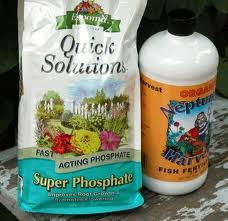Fertilising Plants
 Most plants will benefit from a feed throughout the year. Fertilising our gardens helps keep the nutrient content in check. In time, established plants use up all the goodness in surrounding soil so they will require a top up every now and then.
Most plants will benefit from a feed throughout the year. Fertilising our gardens helps keep the nutrient content in check. In time, established plants use up all the goodness in surrounding soil so they will require a top up every now and then.
Some plants such as fruit trees, vegetables and roses are super productive so require extra fertilising.
Fertilisers are not “food” for plants. Plants manufacture their own sugars from the sun, via photosynthesis, but they are necessary to enable plants to function effectively.
Carbon, oxygen and hydrogen are all essential elements required for plant growth. Plants optain these elements from the air and water. All other elements they require for healthy growth are dissolved in water and taken up via the plant’s roots, or to a limited extent, via its leaves.
There are 3 major elements that plants require:
- Nitrogen (N) – this is important for leaf growth and is a necessary part of the green pigment chlorophyll
- Phosophorous (P) – this is important for cell formation so is most needed by the growing parts of plants. It promotes the development of seedlings, root growth, flowering and formation of fruits and seeds
- Potassium (K) – this assists in photosynthesis. It assists the plant’s overall strength and water uptake and disease resistance and improves the quality of flowers, fruit and seeds
Minor elements that are also required for healthy plant growth are:
- Calcium (Ca) – this forms the wall structure. It is available in lime, superphosphate and gypsum but it is quickly leached out by heavy rain.
- Sulphur (S) – this forms part of the plant protein. Deficiency is rare as sulphur is found in most plant foods
- Magnesium (Mg) – this is important in photosynthesis as it is present in chlorophyll. New leaves have first call on this nutrient and as magnesium moves readily through the plant’s system, deficiency is most often evident with the yellowing of older leaves. A magnesium boost is supplied by an applicaion of Epsom Salts dissolved in water
- Trace Elements – Iron, Manganese, Zinc, Copper, Boron, Molybdenum – these are essential to plant growth but are only needed in minute amounts. Use these sparingly
There are 2 types of fertilisers – organic and inorganic. Organic fertilisers include:
- Animal manures – excellent for improving the soil structure when used in large quantities but their nutrient value is relatively low.
- Pelletised poultry and sheep manures – release nutrient over a long period of time as the pellets break down.
- Blood and bone – this is a slow release fertiliser made from the waste products of abbatoirs. It provides a very gentle, long term feeding. It does not contain potassium.
- Green manure crops – leguminous plants such as peas can be grown and dug into the soil after flowering. These plants trap atmospheric nitrogen so are a rich nitrogen source for your garden.
Inorganic fertilisers include:
- Powdered and granular NPK fertilisers – these come in different formulations to suit different types of plants such as lawns, roses, camellias, natives etc. They are usually high in nitrogen so can be damaging to plants unless they are well watered in
- Water soluble and liquid fertilisers – these are designed to dissolve rapidly in water and are applied directly to plants via a watering can
- Controlled release fertilisers – these are NPK fertiliser particles surrounded with a protective coating that dissolves when water penetrates it. The rate of nutrient release is controlled by temperature which means more nutrients are released when plants are growing
You do need to be careful not to overfeed plants as this can make leaves softer and more suspectible to disease. Most plants require feeding in the warmer months as this is when they are growing. If a plant is dormant, it will not require feeding.
Comments are currently closed.
 Gardening Gals
Gardening Gals
